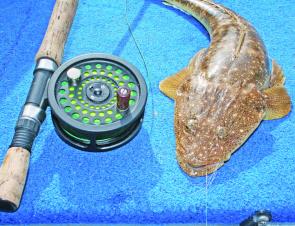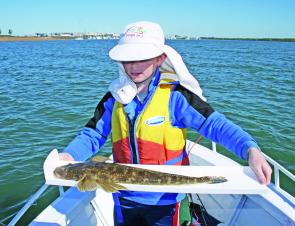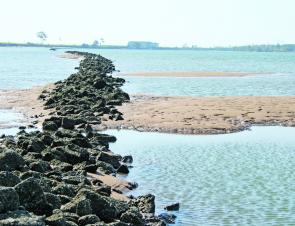When it comes to saltwater flyfishing, few fish are as accommodating as the humble flathead. Flatties are easy to locate, take flies readily and put up a spirited flight on suitable fly tackle. In fact, it would be hard to nominate a better species to cut your teeth on as a newcomer to the sport. But don’t be fooled into thinking flatties are easy to fool.
Like any species targeted on fly gear, you still need to have a basic understanding of flathead’s habits, likes and dislikes and then be able to deliver them a fly in a way they expect to see their prey arrive. Flathead may not be as challenging as other tropical glamour species, but finding and fooling the better specimens still require a degree of skill and expertise. And of course, as a fly fisher once you have developed the skills necessary to take flatties on a consistent basis, it certainly gives you a solid platform from which to branch out to challenging targets if that’s what you want to do.
Most fly fishos target flathead up in the shallows over the sand flats. But here in Bundaberg, we often have to take a slightly different tack and chase flatties along the rock walls, which line the main channel of the Burnett River. The flatties tend to haunt the walls because the Burnett is a fairly deep and uniform river and it just doesn’t have extensive flats like you’ll find in the Baffle or over the other side of the wall in Skyringville.
This is no problem to the fish, as they are quite happy to sit in tight, right along the base of the rock walls and pounce on the massive schools of baitfish which parade by. In fact, I think the method of hunting they have adopted is one of the reasons why Burnett flatties carry so much weight for their length. On average, a big flattie out of the Burnet might have a kilo or more on similar sized flathead from the Baffle or Kolan rivers.
For the fly angler, having a nicely defined edge to fish along also makes finding the fish a simple process. By working your way along the wall, you will eventually come across concentrations of fish and then you can spend some time targeting them.
Using the fly rod to pull flathead off the Burnett River rock walls is a fairly straight forward process. The idea is to drift along with the tide, casting your fly right in hard up against the rocks, and then working it back out with a series of short, sharp strips, interspersed with long enough pauses to allow the fly to settle back to the bottom each time.
The key is to control the rate of drift, to enable your fly enough time down near the riverbed where the flatties are lying. If you can’t control the drift, you will find the boat travelling along so fast that the fly is being dragged out of the strike zone, before the fish have had a chance to find it.
An electric motor is the answer. With a bow-mounted electric, you are able to continually adjust the speed you are drifting and the distance you are sitting out from the wall, without even having to interrupt your casting. Ideally, you need to be out just far enough so that you are not drifting over the top of the fish and spooking them, yet close enough so that your average cast is landing close enough to the stones to develop a serious case of gravel rash.
While the flatties are nearly always concentrated in a narrow band close in to the wall, they generally aren’t spread out all along its entire length. Instead, they tend to congregate in small patches, where channels and sandbars funnel the baitfish and make the pickings easy. Therefore, any irregularities in the bottom formation or shape of the wall itself should get extra attention from fly fishers. Many times I have prospected along a couple of hundred metres of the North wall for no result, only to stumble onto a little hot spot and take a dozen flatties within the next 20-30m.
Flatties are not fussy fish and will generally accept most flies, provided the flies have sufficient weight to get down to them. I have had quite a lot of success with good old Clouser patterns in chartreuse and white, pink and white, pink and yellow and even plain white for that matter.
When the water is a little discoloured, I tend to go for a rattling version of the Clouser. The noise and the extra flash from the mylar belly all help to make the fly easier for the fish to see. The gaudier rattling Clouser is also a good choice when I’m fishing over on the ocean side of the north wall, where the waves churn up the bottom sediment, reducing the visibility.
I tie all my own flies and so have the luxury of being able to turn out whatever type or size of fly I need. Generally, I tie my Clousers so they are around 75mm or sometimes a little longer. This size is a good compromise between being big enough to interest the fish and still being easy enough to cast on my 7 weight Black Diamond fly rod.
While flatties are real performers on the long rod, there probably isn’t one which couldn’t be comfortably handled on a 7 weight outfit. It is more of a case of being able to cast reasonably heavily weighted flies of a sufficient size than it is about fish fighting capabilities.
Quite a bit of my fishing is done in conditions of waves or swell, so I favour a fairly fast sinking fly line for my flattie fishing. This probably goes against the accepted methodology, but when the waves and wind are pulling the boat and line around, your fly needs all the help it can get to sink to the bottom, before it gets pulled too far out from the base of the wall. Honestly, even fast sink lines don’t get down that quickly in salt water due to the higher density, so there is little chance of the line getting down to the bottom and lining the fish before the fish gets a chance to see the fly.
Finally, there is no need for a fancy leader set-up for flattie flyfishing. I run a metre or so of 15kg mono as a butt section and then about a metre of 9kg fluorocarbon right through to the fly. This is more than enough to cope with the flattie’s abrasive teeth, without being too obtrusive. At times, I have gone down to 6kg when the fish have been fussy and the water extra clear but sooner or later you hook a bigger than average fish, which always seems to end in tears.
With the popularity of soft plastics over the last decade or so, a lot of anglers seem to have forgotten just how much fun flyfishing can be, even for ordinary species like flathead and bream. The truth is, flyfishing can be just as deadly as a well worked plastic and I’ve often out fished bait anglers working the same section of wall.
While flyfishing used to be considered a bit of an expensive pastime, but with the price of quality threadline tackle these days, fly gear has actually become a lot more comparable and is quite affordable if you shop around. So go on, get out there and give the fly a try.
Reads: 4122
An average flattie taken from the North wall of the Burnett River. As you can see, the fly is only just visible, giving you some idea of how confidently they take fur and feather fakes.

A plain white Clouser with another victim.

Occasionally the bream get in on the act, but as a rule, smaller flies are better on these guys.

At 52cm, this one is a little larger than average.

This small wall a little further upstream in the Burnett can also produce fish if you work the irregularities in the structure.

The North wall of the Burnett is a flathead haven.




